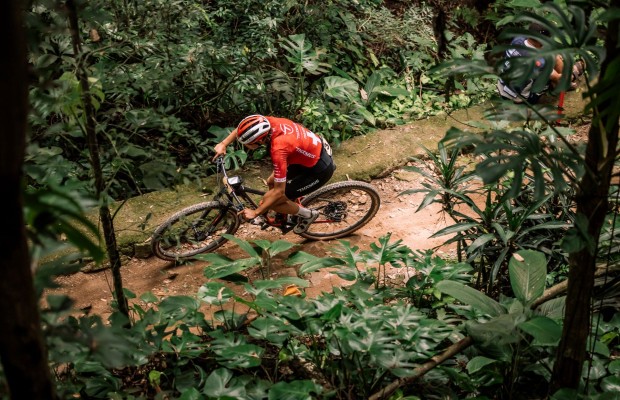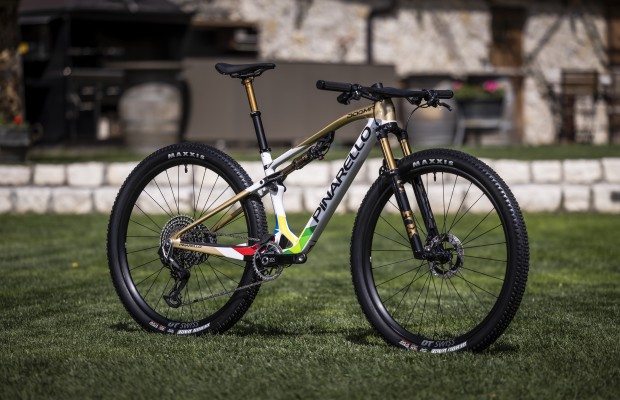We tested the Pinarello Dogma XC, a mountain bike designed with the sole purpose of winning
Although this Pinarello Dogma XC has been racing and winning everything in the professional XCO circuit for a couple of seasons, it wasn't until now that the brand formally presented it. Pinarello invited us to its debut in the Italian town of Riva del Garda and there, alongside the project managers who explained everything about it, we were able to test it.

Pinarello Dogma XC: designed with the sole purpose of winning
Usually when a bike is designed, the brand thinks about the market and uses competition as a showcase, but Pinarello has done it the other way around. They have built a bike tailored to their riders, specifically Tom Pidcock has been involved in the creation process of the Dogma XC. Pauline Ferrand Prevot has been the driving force behind the rigid version.
So much so, that they confessed at Pinarello that the bike has not been tested by more riders than themselves, and we were the first, apart from the project, to test the bike, being very interested in the feedback we could provide.
RECOMENDADO

Cannondale Scalpel 2024: it looks like a restyling but it is a true renovation

New Specialized Epic 8: 120mm, without BRAIN and lighter, more efficient and faster than ever

Van Rysel RCR Pro Replica from Decathlon-AG2R La Mondiale on sale

Schedule and how to watch the XCO Araxá World Cup 2024

Van der Poel and Pogacar face to face at Liège-Bastogne-Liège 2024

New Pinarello Dogma XC: prices, new features, models and weights

The Dogma XC is a purely racing bike. According to the guidelines set by Pidcock, they have given up on frame travel greater than 100mm. The version that goes on sale has 90mm of rear travel and 100mm of front travel. Riders will have the possibility, by changing the shock and fork, to have 100mm at the back and a 120mm fork on circuits that require it.
They were looking for a tremendously rigid and reactive bike. That's why they arrived at the final design with that additional triangle in the pedal area. In that same area, we can see that the main pivot point of the swingarm is really oversized, as are the chainstays. Seeking a very reactive rear end.
Where they have followed the most common path lately is in the suspension system. Single pivot and without rear articulation, relying on the flex of carbon, simplifying and lightening the system.
As for the geometry, we find in our test unit, which is a size M, a head angle of 67.5° and a seat tube angle of 75.45°, really short chainstays with 427.5mm and a reach of 455mm. It also stands out a fairly low bottom bracket of 323mm in height.

A while ago, this geometry would have seemed like a Down Country style, but seeing where the numbers are moving lately, it seems like a fairly balanced geometry, far from experiments.
What does make the riding position very radical is the -18° angulation of its integrated cockpit, which, combined with a short 90mm stem, makes us quite inclined forward.
A setup to World Cup standards
Our test bike, in addition to wearing the colors of Tom Pidcock's bike (also available in black and red), is assembled in such a way that it could well be on the starting line of a World Cup, although the choice of components differs quite a bit from what Pidcock and Pauline use on their bikes.
First, they turn to Fox for the suspension, with the new and flashy Fox 32 StepCast fork, with its striking inverted bridge, and Fox Float SL shock, both in Factory Kashima version. The suspensions have three compression positions controlled by a remote on the handlebar.
The Fox ecosystem is completed by the Fox Transfer SL seatpost, also in Kashima version, offering 100mm of travel.

For the groupset, they go with the best from Sram, with their XX SL Eagle AXS. However, for the brakes, they use Shimano XTR.
The wheels are DT Swiss XRC1200 Spline, with Maxxis Rekon Race tires. Here, they choose to mount different dimensions front and rear, with 2.35" for the front wheel and 2.25" for the rear.
And the icing on the cake is the spectacular integrated MOst Talon Ultra XC cockpit, with spectacular and quite radical shapes.
Our first contact with the Pinarello Dogma XC
When we went to make the basic adjustments to the bike, we couldn't help but admire a bike that we find really beautiful. Few brands like Pinarello know how to give that aesthetic touch of distinction while remaining elegant.
Live, of course, the frame shapes stand out, with its additional triangle, but also its integrated cockpit with internal cable routing gives it a spectacular finish.
There is also a great design work in its double rocker arm, or rather, rocker arm and shock extender, which fit perfectly and match the suspension at rest.
We made the suspension adjustments and, already standing still, we felt that the suspension feel was going to be quite firm. We set up the controls to our liking and we were struck by the configuration of the seatpost and remote lockout, both on the left side and in line next to each other. We have mentioned many times that the perfect configuration of these two controls is really complicated, if it exists, and although visually the arrangement that the Dogma brings may be surprising, the truth is that it works well, having the seatpost control very handy, which is the one we use most frequently and sometimes in a hurry.
The people at Pinarello had prepared a very varied first route for us where there was a bit of everything to test the Dogma XC in all situations. We started on the shores of Lake Garda, so after a few flat kilometers, which served to get used to the bike handling a bit, it was time to climb.

The first thing to highlight is that very aggressive position we adopt due to the dimensions of the cockpit and the fact that we didn't have any spacers under it. The truth is that the Pinarello looks good going this way as we enjoyed a bike with tremendous acceleration and unmatched energy transmission.
In the first climbs on asphalt or very smooth tracks, we could see how, with the suspension locked out, the bike transmits all our energy and we feel how every watt translates into progress. The stiffness of the frame is clearly felt when pedaling standing up and, with that aggressive position, it is the closest thing to being on a road bike.
Once we entered slightly rougher terrain, we could see that the sensitivity and absorption of small irregularities will not be the strong point of this bike.
However, we found that the rear lockout cable was very tight and affected both the mid position, which was too firm, and the open position, which was not offering all the sensitivity it has. Once the adjustment was fixed, the performance was very good, with the three positions well differentiated, also in the fork, where the mid position was quite different from the open one.

Still, after a few kilometers of pedaling on more or less rough terrain, we almost always resorted to having the suspensions open, as the feel is quite firm at the rear and we hardly noticed any energy loss due to rear oscillation, resorting to the mid position or lockout in areas where we were pedaling standing up.
Racing DNA and fun in one bike
We reached the most challenging areas of the route and the Dogma XC showed us its capabilities. Despite not having long-travel suspensions, impacts of a certain entity are absorbed sufficiently. In the rear, we have a fairly progressive feel that does not crumple under strong impacts, and the front suspension makes excellent use of its 100mm, offering a fairly good initial sensitivity and, at the same time, providing enough support for complicated terrain.
As for the stiffness of the fork, there is nothing to object to. We are increasingly used to forks with 34mm or even 35mm stanchions on XC bikes, and it is true that they give the bike great precision, but the new Fox 32 StepCast has improved a lot in this regard. In addition, the high rigidity of the frame and its integrated cockpit more than compensate for the minimal flex the fork may have, and at all times we feel great control of the steering and precision in the line.

We surprised ourselves when descending technical and quite rough trails, enjoying a bike that, although it doesn't seem the most suitable for it, among other things because of the very racing position we adopt on it, the truth is that it invites us to play since the feeling of control and agility that the Dogma XC provides is very high.
Also in these terrains, we had the invaluable help of its Fox Transfer SL dropper post. We have tested this post on several occasions and sometimes it has not convinced us due to its only two positions, but it has always been in long-travel versions, where it is necessary to lower a lot so that it doesn't rise back up if we don't reach the bottom. But this version with 100mm of travel is perfect for XC, and despite those only two positions, we have a very light post with a balance between smoothness and speed that is one of the best on the market.
Conclusions
It hasn't been much time, just a couple of varied routes, but the Pinarello Dogma XC has left us with a great impression. We hope to enjoy it in the future for a longer time, but it has already shown us its main virtues.
There are few bikes with a more racing spirit than the Dogma XC. It is a bike for those who enjoy speed and pushing themselves to the maximum on every ride, and if it can be with a race number, even better, as that is its natural habitat.
It makes us look back to the past, where XC bikes were much more aggressive, but with the advantage of modern geometry and a dropper post. The best of both worlds to build the fastest bike possible.
Specifications, weight, and price
- Frame: Toray M40 J
- Fork: Fox 32 SC Factory Kashima 100mm
- Shock: Fox Float SL Factory Kashima 190x45
- Groupset: Sram XX SL Eagle AXS
- Brakes: Shimano XTR
- Wheels: DT Swiss XRC1200 Spline
- Tires: Maxxis Rekon Race EXO TR 2.25" / 2.35"
- Seatpost: Fox Transfer SL Kashima, 30.9, 100mm
- Handlebar: MOst Talon Ultra XC
- Weight: 10.45kg
- Frame weight: 1.75kg +252g (shock)
- Price: 13,500€
- Frame+shock kit price: 6,000€